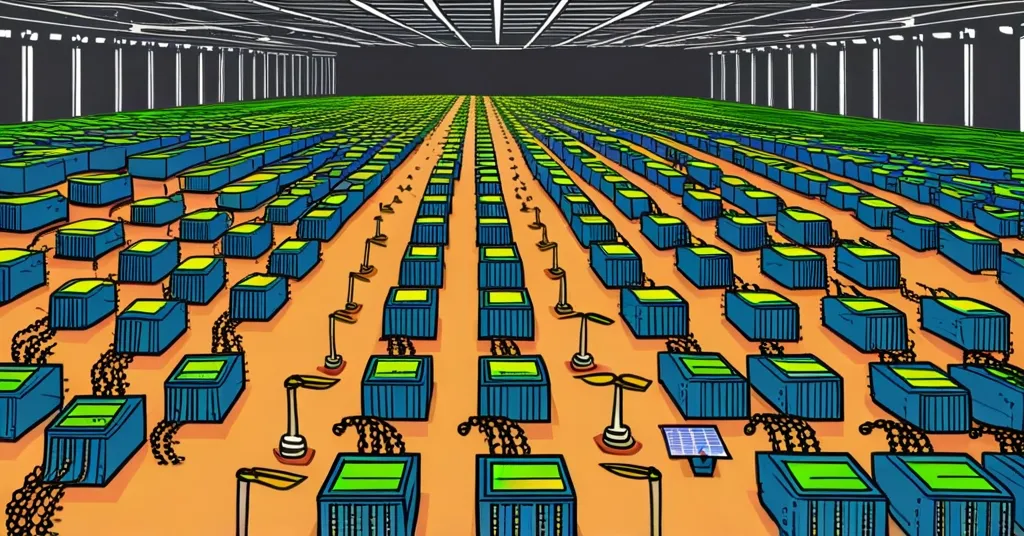Crypto Mining Farms Unveiled: Operations, Types, and Future Trends

Inside the World of Crypto Mining Farms: The Ultimate Guide
Crypto mining farms are vital to the blockchain ecosystem, serving as the backbone for validating transactions and minting new cryptocurrencies like Bitcoin. This guide delves into their operations, types, benefits, challenges, and future prospects, exploring the impact of renewable energy and alternatives like staking.
- How crypto mining farms operate and their types
- Benefits, challenges, and the future of mining
- The impact of renewable energy and alternatives like staking
Introduction to Mining Farms
Crypto mining farms are large-scale facilities filled with specialized computers, known as mining rigs, that work around the clock to solve complex mathematical problems. These problems are essential for validating transactions on blockchain networks and minting new cryptocurrencies. Since Bitcoin’s inception in 2009, mining farms have been integral to the growth of the crypto market, which as of early 2025, holds a valuation of over $3.4 trillion, with only a handful of these digital currencies being mineable.
Mining farms aren’t just about brute force computing; they’re the digital sweatshops where the magic happens. Picture walking into a warehouse filled with thousands of computers, all humming away to solve complex puzzles. That’s a crypto mining farm in action.
How Mining Works
The process of mining involves two primary consensus mechanisms: Proof of Work (PoW) and Proof of Stake (PoS). PoW, used by Bitcoin, requires miners to solve cryptographic puzzles to validate transactions and add them to the blockchain, earning them new coins as a reward. PoS, on the other hand, selects validators based on the number of coins they hold and are willing to ‘stake’ as collateral, which Ethereum has transitioned to, significantly reducing its energy consumption.
Each mining rig within a farm is essentially a high-powered computer designed specifically for mining. These rigs are equipped with ASICs (Application-Specific Integrated Circuits), which are optimized for the mining algorithms of specific cryptocurrencies.
Types of Mining Farms
Mining farms range from industrial giants to home setups:
- Industrial Mining Farms: These are the behemoths of the industry, housing thousands of rigs in vast warehouses. They leverage economies of scale for cost-effectiveness.
- Mid-sized Operations: These strike a balance between scale and manageability, often used by smaller businesses or mining cooperatives.
- Home Setups: Enthusiasts can run smaller operations from their homes, though they often face higher electricity costs per coin mined.
- Cloud Mining: This allows individuals to rent computing power from remote data centers, democratizing access to mining without the need for personal hardware.
- Eco-friendly Farms: With environmental concerns on the rise, some farms are transitioning to renewable energy sources like hydroelectric or wind power.
At CES 2025, Canaan, a leading Bitcoin mining company, unveiled their innovative Avalon Mini 3 and Nano 3S rigs. These devices double as home heaters, making mining more accessible and addressing environmental concerns by repurposing the heat generated during mining. It’s a clever way to keep your house warm while minting some crypto on the side. Learn more about Canaan’s CES 2025 mining rigs.
Benefits and Challenges
Mining farms offer several advantages:
- Cost-effectiveness: By operating at scale, mining farms can reduce the cost per mined coin.
- Blockchain Security: They play a crucial role in securing the blockchain by validating transactions and deterring potential attacks.
- Simplified Mining: Cloud mining services make it easier for individuals to participate without investing in expensive hardware.
However, the challenges are significant:
- High Electricity Costs: The U.S. Energy Information Administration (EIA) estimates that cryptocurrency mining in the U.S. consumes between 0.6% and 2.3% of total U.S. electricity. That’s a lot of juice!
- Cooling Requirements: Sophisticated cooling systems are necessary to prevent overheating, adding to operational costs.
- Initial Investment and Maintenance: The upfront cost of mining rigs and ongoing maintenance are substantial hurdles for new entrants.
Environmental Impact
The environmental impact of mining farms is a contentious issue. The high energy consumption associated with PoW mining has led to a push for more sustainable practices. Some miners are relocating to regions with abundant renewable energy, such as hydroelectric power in the Pacific Northwest or wind power in Texas.
But it’s not just about relocation. Mining farms are also getting creative with energy use. For instance, participating in demand-response programs like ERCOT’s Large Flexible Load program in Texas allows miners to adjust their operations to meet grid demands, potentially mitigating some of the energy concerns. It’s like being a good neighbor in the energy world. Explore more about eco-friendly crypto mining farms.
Future Trends
The future of crypto mining farms looks promising with ongoing technological advancements. Newer, more energy-efficient ASICs are being developed, which could significantly improve mining efficiency. The shift towards renewable energy sources is also expected to continue, reducing the environmental footprint of mining.
However, the rise of alternatives like staking, exemplified by Ethereum’s transition to PoS, could reduce the reliance on traditional mining. While Bitcoin’s conservative core developers are unlikely to make a similar shift soon, the conversation around PoS and other consensus mechanisms is evolving. Understand more about the impact of Ethereum’s transition to Proof of Stake.
Regulatory pressures are also shaping the future of mining. For example, New York’s temporary ban on new cryptocurrency mining permits at fossil-fuel plants and the European Union’s upcoming Markets in Crypto Assets (MiCA) bill highlight the growing regulatory scrutiny. Mining farms must navigate these challenges while continuing to innovate.
Key Takeaways and Questions
- What is a crypto mining farm?
A crypto mining farm is a large facility where numerous specialized computers, called mining rigs, solve complex mathematical problems to validate transactions on blockchain networks and mint new cryptocurrencies.
- How do crypto mining farms operate?
Crypto mining farms operate by setting up networks of powerful computers to solve complex mathematical equations required to validate cryptocurrency transactions, minting new coins and securing the blockchain.
- What are the different types of cryptocurrency mining farms?
Types include industrial mining farms, mid-sized setups, home mining farms, cloud mining, and eco-friendly mining with renewable energy sources.
- What are the benefits of cryptocurrency mining farms?
Benefits include cost-effectiveness due to economies of scale, enhanced blockchain security, and simplified mining processes through cloud services.
- What challenges and costs are associated with running a mining farm?
Challenges include high electricity and cooling costs, significant upfront investment in mining rigs, and ongoing maintenance requirements.
- What does the future hold for crypto mining farms?
The future looks promising with technological advancements and a shift to renewable energy, though the rise of alternatives like staking may reduce the demand for traditional mining.



